Top Email Writing Tips to Boost Your Productivity
Learn how to craft compelling emails that get results with these seven essential tips. From writing clear subject lines to structuring for scannability, discover how to improve your email communication and achieve better outcomes.
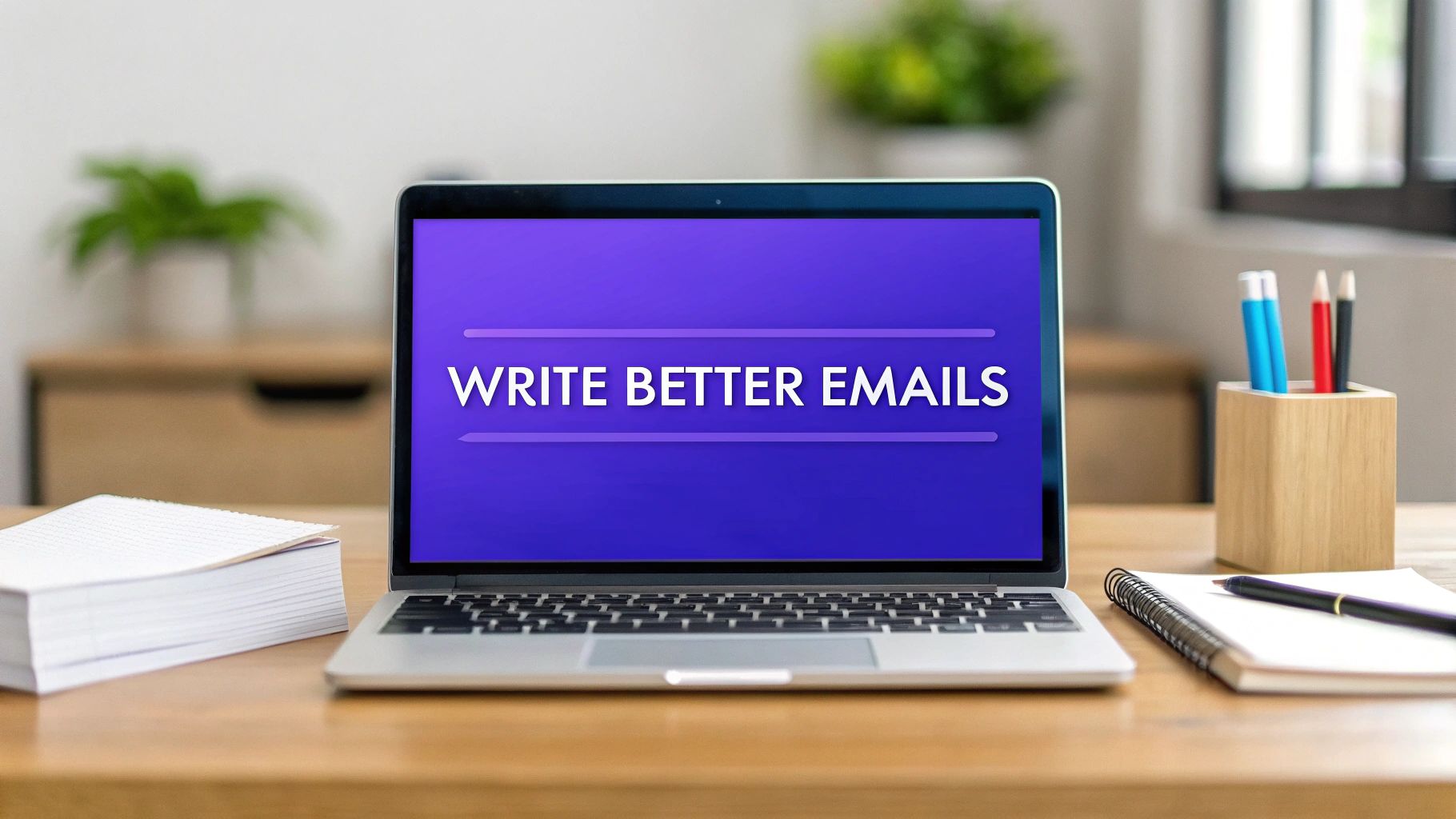
Supercharge Your Inbox: Essential Email Writing Tips
Effective communication is crucial for success. This listicle provides seven actionable email writing tips to improve clarity, boost your productivity, and save you time. Learn how to craft compelling subject lines, structure emails for readability, write concisely, and close with clear action items. These email writing tips will help professionals, marketers, customer support teams, and entrepreneurs alike communicate more effectively and achieve better results.
1. Craft Clear and Concise Subject Lines
The subject line is the first impression your email makes. In the crowded digital landscape of today's inbox, it's the gatekeeper that determines whether your carefully crafted message is even opened, let alone read. It's the equivalent of a headline in a newspaper, grabbing attention and enticing the reader to delve deeper. A well-crafted subject line, typically under 50 characters, acts as a concise summary of the email's content, providing the recipient with enough information to gauge its relevance and importance. This element is crucial for effective email writing tips because it directly impacts your email's visibility and success.
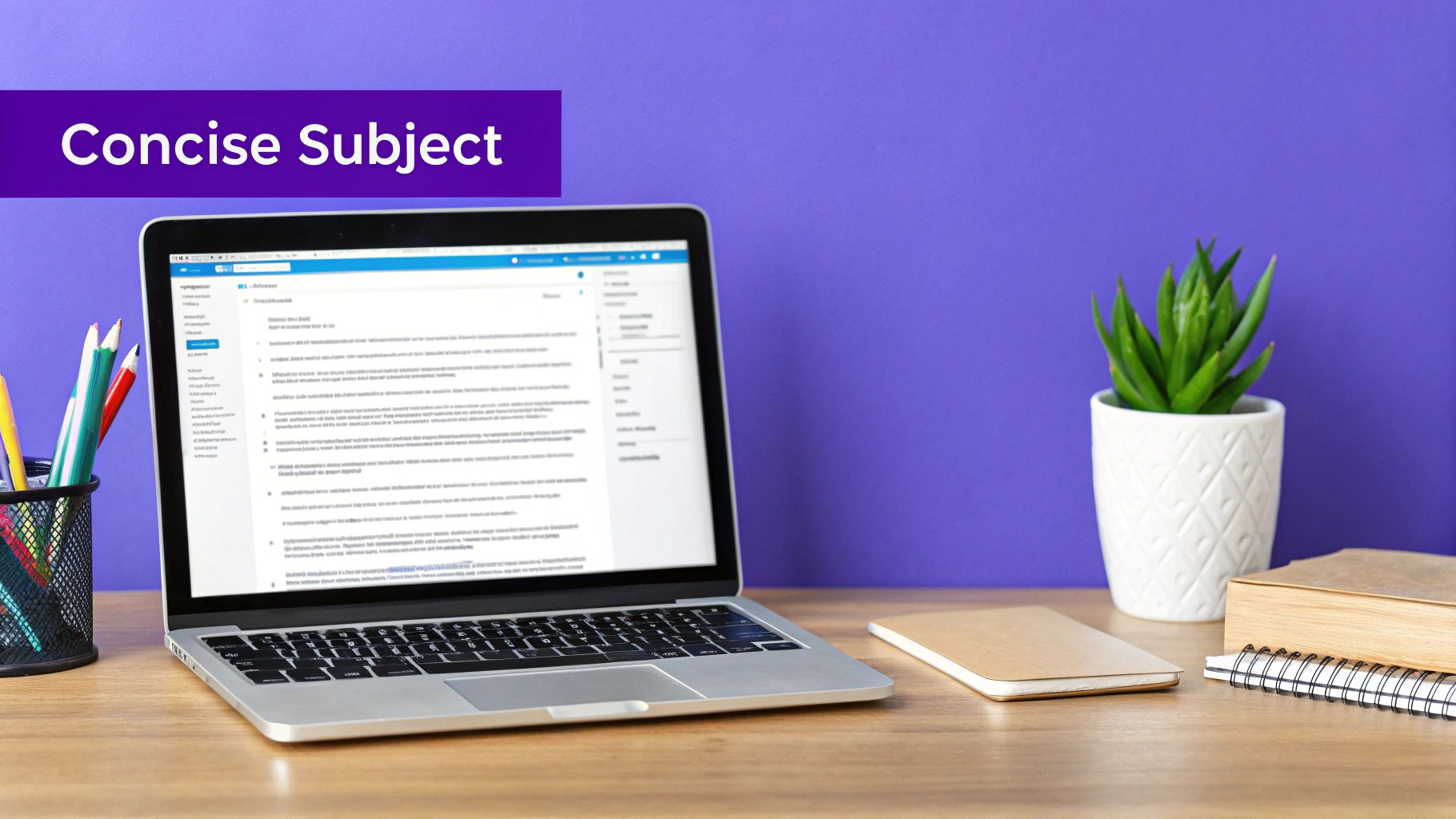
A strong subject line possesses several key features. Ideally, it's between 6-10 words, conveying the main purpose upfront while avoiding vague or misleading language. It clearly communicates the value proposition for the recipient, answering the implicit question, "Why should I open this?" This is especially crucial for busy professionals, sales and marketing teams, customer support staff, freelancers, entrepreneurs, and event organizers who are constantly bombarded with emails.
Consider these examples demonstrating improved subject lines: Instead of a generic "Meeting," use "Marketing Budget Meeting - Decision Needed by Friday." Instead of a simple "Question," try "Quick Question About Project Timeline." Instead of a vague "Update," opt for "Q3 Sales Results: 15% Above Target." These examples showcase how to frontload critical information and set clear expectations, ultimately encouraging higher open rates. Learn more about Craft Clear and Concise Subject Lines
The benefits of effective subject lines are numerous. Increased open rates translate directly into higher engagement with your message. Clear expectations prevent confusion and wasted time, allowing recipients to prioritize their inbox effectively. Specific subject lines also make it easier to search for emails later, improving overall workflow efficiency. On the other hand, condensing complex topics into a few words can be challenging. It may require multiple revisions to achieve the perfect balance of brevity and clarity. Additionally, cultural differences can influence the interpretation of language, making it essential to consider your audience when crafting subject lines.
Actionable tips for optimizing subject lines include incorporating action words when a response is required (e.g., "Approve Proposal by EOD"). Use numbers when relevant, such as "5 Items for Review," to pique interest. Test different subject lines with A/B testing to identify what resonates best with your audience. Critically, avoid using ALL CAPS and excessive punctuation (!!!) as these practices often trigger spam filters, hindering your email's deliverability. This advice aligns with email efficiency techniques popularized by experts like Tim Ferriss, as well as email marketing guides from industry leaders like MailChimp and HubSpot. By mastering the art of crafting clear and concise subject lines, you significantly improve the chances of your email being read and acted upon, making this item a fundamental component of effective email writing tips.
2. Know Your Audience and Purpose
One of the most crucial email writing tips is to know your audience and purpose. This foundational principle underpins effective communication and dictates every aspect of your email, from tone and style to content and structure. Before drafting any email, take the time to analyze who you're addressing and what you aim to achieve. Understanding your audience's knowledge level, expectations, and relationship to you will inform your communication style, the level of detail you include, and the overall formality of your message. Simultaneously, clarifying your purpose ensures your email remains focused, actionable, and delivers the intended message.
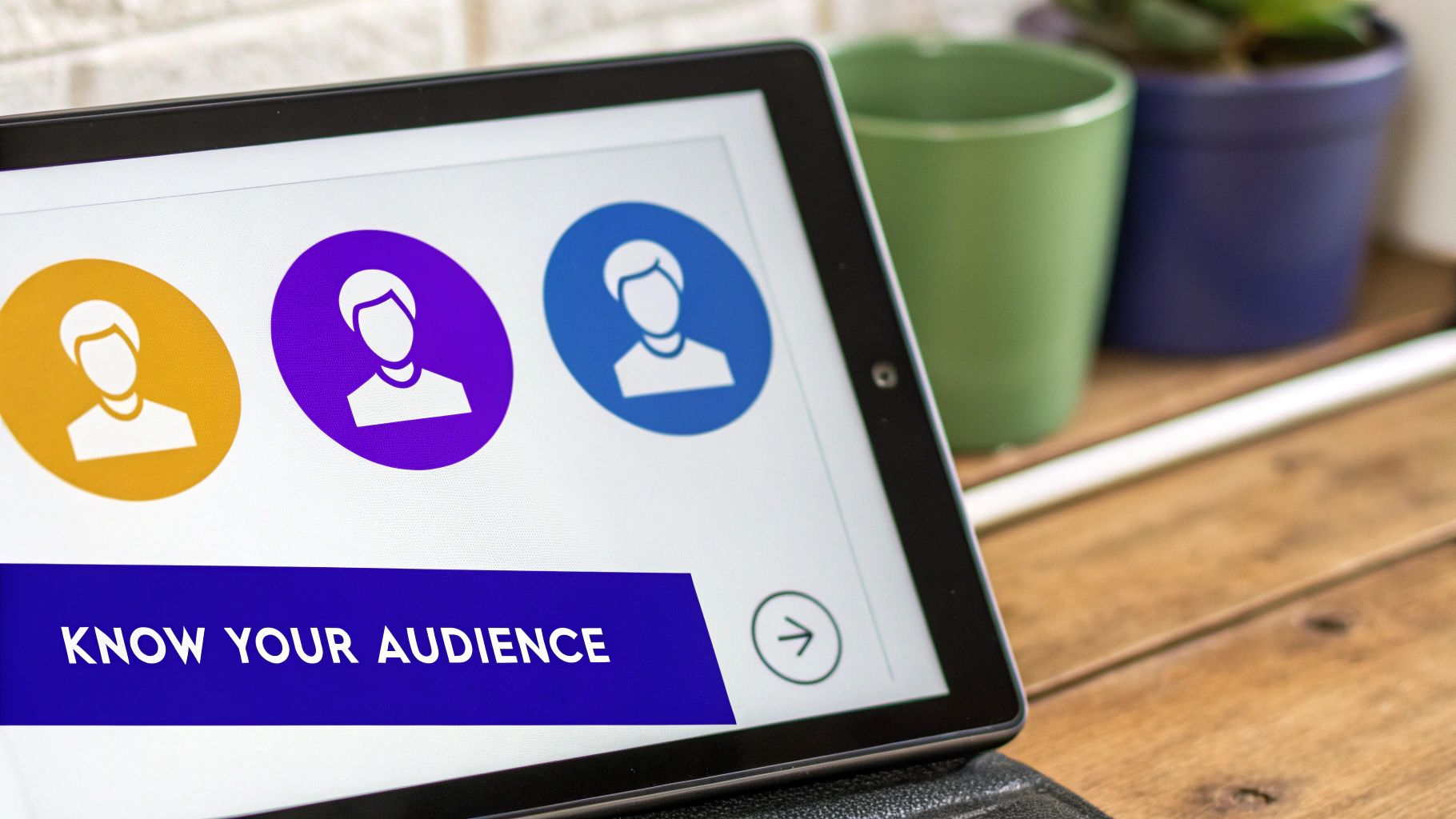
This approach involves tailoring your communication style to the specific recipient. Are you emailing a CEO, a technical team, or a potential client? Each audience requires a distinct approach. For a CEO, a brief, bottom-line-up-front approach with a concise executive summary is most effective. A technical team, on the other hand, benefits from more detailed information, including relevant specifications and data. When communicating with clients, adopt a professional yet approachable tone, highlighting clear value propositions. Establishing clear communication goals from the outset guides your content decisions and organization. Knowing whether you're seeking information, requesting action, or simply building rapport will shape the structure and flow of your email.
This principle earns its place on the list of essential email writing tips due to its profound impact on communication effectiveness. Its key features include tailoring communication style, establishing clear goals, guiding content and organization, and determining the appropriate formality level. The benefits are significant: preventing miscommunication and confusion, saving time by avoiding unnecessary revisions or follow-ups, building stronger professional relationships, and increasing the likelihood of achieving your desired outcome.
While the advantages are clear, there are some potential drawbacks. Knowing your audience and purpose requires research and thoughtful consideration before writing. It can also be challenging when emailing multiple stakeholders with different needs, requiring carefully structured content to address each audience effectively. Similarly, communicating with unfamiliar recipients can present difficulties in gauging the appropriate tone and level of detail.
Examples:
- To a CEO: "Subject: Q2 Revenue Summary & Key Initiatives. Dear Mr./Ms. CEO, Q2 revenue exceeded projections by 15%. Attached is a summary outlining key contributing factors and proposed initiatives for Q3. Please let me know if you require further clarification. Sincerely, [Your Name]"
- To a technical team: "Subject: API Integration Specifications. Hi Team, Please find attached the detailed specifications for integrating the new API. Section 3.2 outlines the authentication process, and Section 4.1 details the data format requirements. Please review and let me know if you have any questions by [date]. Thanks, [Your Name]"
- To clients: "Subject: Introducing Our New Productivity Solution. Dear [Client Name], We're excited to announce the launch of our new productivity solution designed to streamline your workflow and boost efficiency. Click here to learn more and schedule a free demo: [link]. We look forward to hearing from you. Sincerely, [Your Name]"
Actionable Tips for Implementing This Email Writing Tip:
- Research recipients: If possible, research recipients before writing to understand their background and interests.
- Anticipate questions: Consider what questions they might have and proactively address them in your email.
- Adjust technical language: Use technical jargon judiciously, adjusting based on the recipient's expertise.
- International audiences: For international communication, avoid idioms and cultural references that may not translate well.
- Multiple recipients: When emailing multiple recipients with varying needs, use clear headings and concise summaries to organize information effectively.
The importance of knowing your audience and purpose has been popularized by various influential sources, including Harvard Business Review's communication articles, Barbara Minto's Pyramid Principle for business communication, and Grammarly's audience awareness guidelines. By consistently applying this principle, you can significantly enhance the clarity, effectiveness, and impact of your email communications.
3. Structure for Scanability
In the fast-paced world of business, effective communication hinges on respecting your recipient's time. Most professionals scan emails rather than meticulously reading every word. Therefore, structuring your emails for scannability is crucial for conveying your message and prompting desired actions. This involves strategically formatting your email to ensure key information is easily accessible at a glance. This not only acknowledges the recipient's limited time but also significantly improves the likelihood of your message being understood and acted upon.
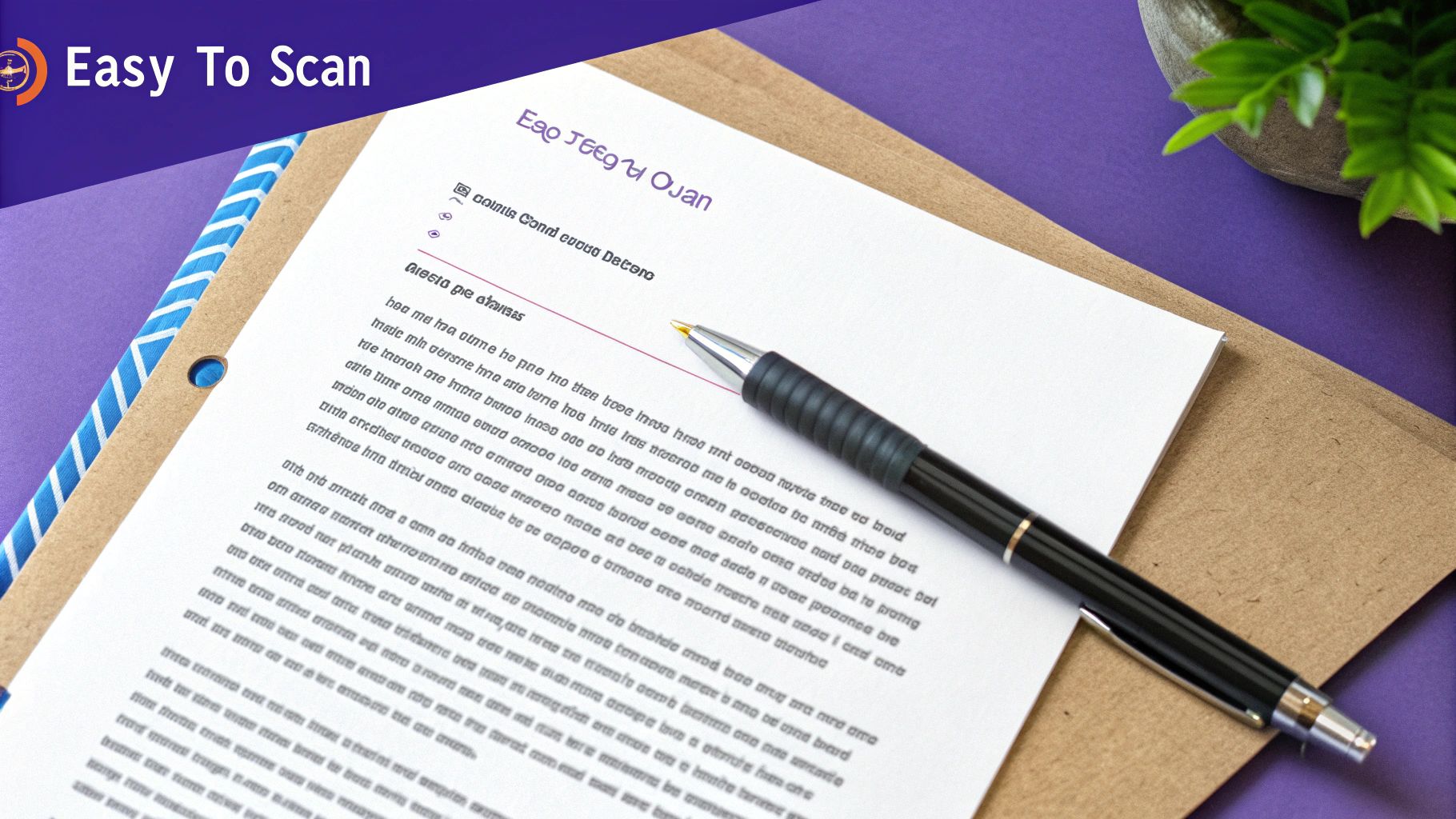
This approach utilizes several key features: short paragraphs (3-5 lines maximum), strategic use of white space, bulleted or numbered lists for multiple items, bold text for key information, and descriptive headings for longer emails. By implementing these formatting techniques, you transform a dense wall of text into easily digestible chunks of information.
The benefits are numerous. Scannable emails improve comprehension and retention by highlighting key takeaways. They make complex information more digestible and reduce the cognitive load for readers, ultimately increasing the likelihood of a response. Furthermore, scannable formatting is inherently mobile-friendly, catering to the growing number of professionals who access emails primarily on their smartphones.
However, there are some potential drawbacks. Oversimplification of complex topics is a risk when condensing information. Very short emails can sometimes appear overly formal when structured with bullet points and headings. Finally, this approach requires a small investment of additional formatting time.
Several successful companies demonstrate the power of scannable email structures. Basecamp, known for its efficient project management software, encourages internal emails to follow a 'TL;DR' (Too Long; Didn't Read) format with a summary at the beginning. Amazon's famous 'six-page memo' structure, while originally designed for internal documents, can be adapted for emails to present information clearly and concisely. Google promotes the use of bullet points with bold action items for quick comprehension and efficient decision-making.
To create highly scannable emails, consider these email writing tips: Use a single idea per paragraph. Put action items in bold or in a separate section. For lengthy information, consider attachments with a summary in the email body. Use headings like 'Background,' 'Current Status,' and 'Next Steps' to guide the reader. Finally, test your email's scanability by quickly glancing at it yourself before sending.
While structuring your emails for scannability, consider the same principles apply to other professional content platforms. Writing a compelling LinkedIn article, for instance, requires similar considerations for formatting and readability. You'll want to ensure your content is easily digestible and engaging for your target audience.
This method’s effectiveness stems from principles rooted in web usability. The Nielsen Norman Group, pioneers in user experience research, advocates for clear information hierarchies and concise content. David Allen's Getting Things Done methodology emphasizes clarity and actionability, which align perfectly with scannable email practices. Jakob Nielsen's F-pattern reading research demonstrates how users tend to scan content online, reinforcing the importance of placing key information strategically. By applying these principles to email, you can dramatically improve your communication effectiveness.
4. Start Strong with a Clear Opening
A strong opening is crucial for effective email writing. It sets the tone, establishes context, and guides the reader into the main message. This front-loaded approach respects the recipient's time and improves the likelihood of your email being read and acted upon. A well-crafted opening immediately orients the reader, provides necessary background information, and smoothly transitions into the main content. In professional communication, getting straight to the point while maintaining courtesy is key for maximizing impact.
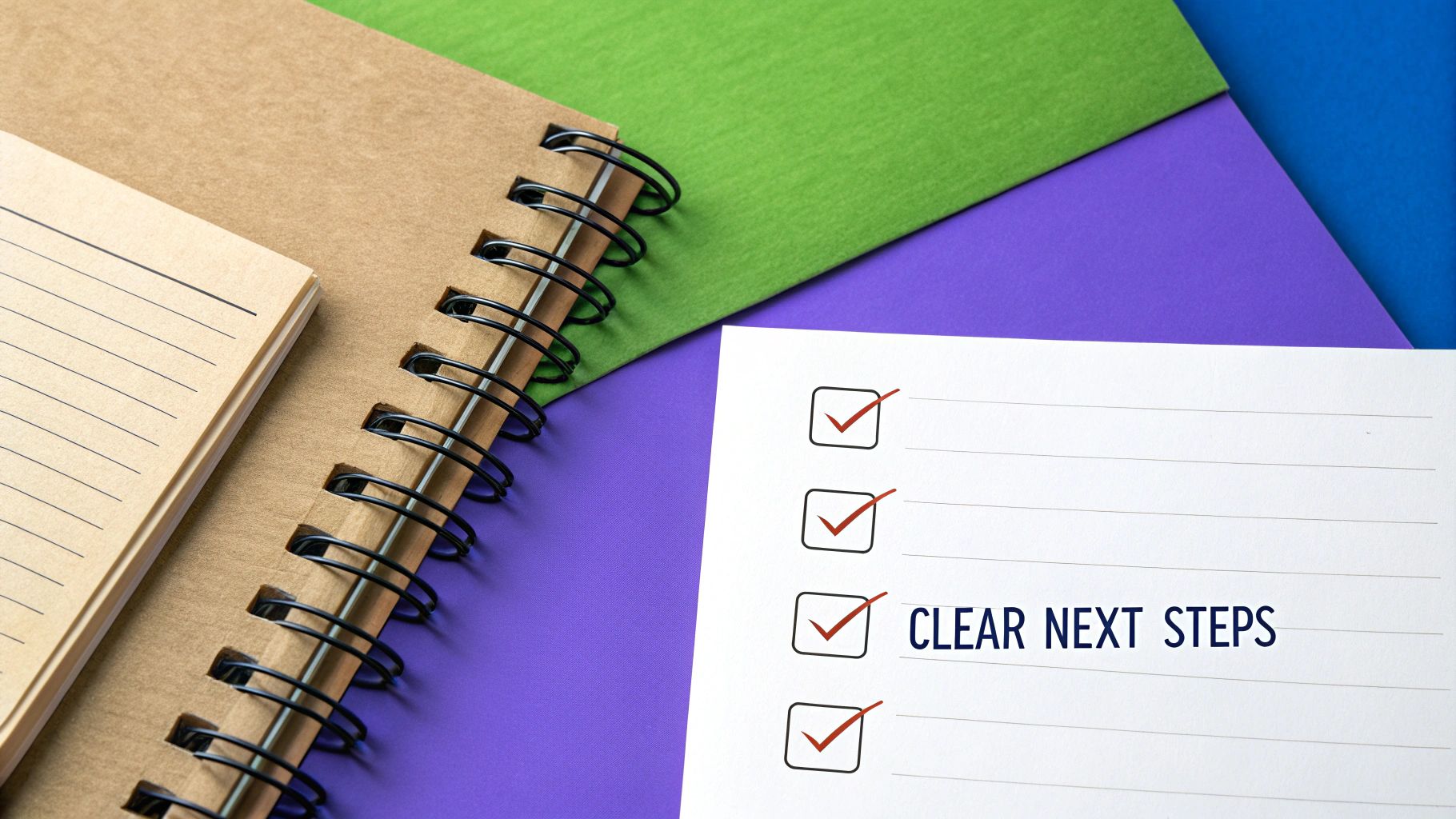
This email writing tip deserves its place on the list because it directly impacts how recipients perceive and engage with your message. Features of a strong opening include a personalized greeting using the recipient's name, a context statement connecting to previous conversations or establishing the email's purpose, a preview of the content or requested action, and an appropriate level of warmth based on your relationship with the recipient.
Examples of Effective Openings:
- Follow-ups: "Following our conversation yesterday about the Johnson project, I've prepared the requested timeline..."
- Cold Emails: "As [Company]'s HR Director, I thought you might be interested in our new compliance training that helped similar organizations reduce audit issues by 40%."
- Updates: "The quarterly report is now complete, with three key findings highlighted below:"
Actionable Tips for Crafting Strong Openings:
- Skip unnecessary pleasantries: In ongoing conversations, avoid generic phrases like "I hope this email finds you well."
- Establish credibility (cold emails): Immediately state your connection point or reason for reaching out.
- Frame your purpose: Use the first sentence to clearly explain why you're writing.
- International communication: Research appropriate greeting conventions to avoid cultural misunderstandings.
- Action requests: Start with "I'm writing to request..." for clarity and directness.
Pros of Starting Strong:
- Immediately engages the reader
- Sets the tone for the entire email
- Provides crucial context
- Helps recipient determine priority and reading approach
Cons to Consider:
- Balancing brevity with sufficient context can be challenging.
- Cultural expectations for email openings vary globally.
- Overly direct openings may seem abrupt in certain contexts.
Why This Approach Works:
This method draws on established principles of influence and effective communication, as popularized by experts like Robert Cialdini (principles of influence applied to business writing) and Ramit Sethi (email networking techniques). It also aligns with best practices recommended by institutions like Carnegie Mellon (email writing guidelines).
When to Use This Approach:
This technique is beneficial for all professional email communication, including internal communication within a company, external communication with clients or partners, networking emails, sales outreach, and customer support interactions. It's particularly crucial for time-sensitive messages, complex requests, and initial contact with new individuals. By prioritizing a clear and concise opening, you enhance communication efficiency and foster stronger professional relationships.
5. Be Concise and Specific
In the fast-paced world of business, brevity and specificity are not just stylistic choices; they're essential email writing tips for maximizing impact and respecting your recipient's time. This approach ensures your message is clear, actionable, and more likely to be read and addressed promptly. It involves eliminating unnecessary words, using precise language, and focusing solely on what the recipient needs to know or do. This principle deserves a prominent place in any list of email writing tips because it directly addresses the common pitfalls of cluttered inboxes and communication breakdowns.
How it Works:
Concise and specific email writing hinges on delivering maximum information with minimum verbiage. It prioritizes clarity and actionability. Instead of meandering introductions or vague requests, get straight to the point. Clearly state your purpose, provide only the necessary details, and specify the desired outcome or action.
Features of Concise and Specific Emails:
- One main topic per email: Avoid bundling multiple unrelated requests into a single email. This can lead to confusion and delays in addressing each item.
- Elimination of filler words and phrases: Purge your writing of unnecessary words like "just," "very," "really," and redundant phrases that add no value.
- Precise language that avoids ambiguity: Use concrete language and avoid jargon or vague terms that might be misinterpreted.
- Specific dates, times, numbers, and expectations: Whenever possible, quantify your requests and provide clear deadlines.
- Strategic use of active voice: Active voice makes your writing more direct and easier to understand.
Examples:
Instead of: "We should meet sometime soon to discuss this further."
Write: "Can we meet Tuesday at 2PM to finalize the budget?"
Instead of: "I'm attaching some files related to the project."
Write: "Attached are the three vendor quotes for the website redesign, ranging from $15,000-25,000."
Instead of: "Please review when you get a chance."
Write: "Please review the proposal by Thursday, focusing on the pricing section on pages 3-4."
Actionable Tips for Writing Concise and Specific Emails:
- Write a draft, then cut it by at least 30% before sending: This forces you to prioritize the most crucial information.
- Specify exactly what action you need and by when: Make it easy for the recipient to understand what's expected of them.
- Replace phrases like "a large number of" with specific figures: Quantify your statements to enhance clarity.
- Use bullet points for multiple specifications or requirements: This improves readability and makes it easier to scan for key information.
- Read your email aloud to identify wordiness or unclear statements: This helps you catch awkward phrasing and ensure a natural flow.
Pros:
- Increases likelihood email will be read completely: People are more likely to engage with short, focused emails.
- Reduces misunderstandings and follow-up questions: Clarity minimizes the need for clarification.
- Shows respect for recipient's time: Brevity demonstrates that you value their time.
- Makes your requests more likely to be fulfilled correctly: Clear instructions lead to accurate execution.
Cons:
- May seem abrupt if too brief in certain cultural contexts: Be mindful of cultural norms and adjust your tone accordingly.
- Can be difficult to balance with necessary politeness: Strive for a balance between conciseness and courtesy.
- Might omit nuance in complex situations: For highly complex topics, more detailed communication might be necessary.
Popularized By:
The emphasis on concise communication has been championed by influential figures like Jeff Bezos, whose "no PowerPoint" email culture at Amazon prioritized written narratives. The principles of Strunk & White's Elements of Style also align with this approach, advocating for clear and concise writing. Guy Kawasaki's "fewer than five sentences" email approach further reinforces the power of brevity.
By implementing these email writing tips and embracing conciseness and specificity, you can significantly improve your communication effectiveness and build stronger professional relationships.
6. End with Clear Action Items
One of the most impactful email writing tips you can implement is ending your messages with clear action items. This technique transforms a potentially ambiguous communication into a powerful driver of results. By explicitly stating the next steps, deadlines, and ownership for any given request or discussion, you significantly improve follow-through and prevent crucial tasks from slipping through the cracks. This practice is especially critical for business professionals, sales and marketing teams, customer support staff, freelancers, entrepreneurs, and event organizers who rely on email for efficient communication and project management.
This approach works by eliminating guesswork. Instead of leaving the recipient wondering what they should do next, you provide a clear and concise roadmap. This clarity fosters accountability and provides a natural framework for tracking progress. For instance, rather than a vague closing like "Let me know your thoughts," a message ending with "Please approve or suggest revisions to the budget by Friday, May 15 at 3pm" leaves no room for misinterpretation. The recipient knows precisely what’s expected, when it’s due, and who is responsible.
Effective action items possess specific features: explicit requests or expectations, concrete deadlines (including dates and times), and clear ownership assignments. Limiting the number of action items, ideally to one to three, prevents overwhelming the recipient. Finally, the action items should have a logical connection to the email’s overall purpose.
Examples of successful implementation:
Instead of: "Let me know your thoughts."
Use: "Please approve or suggest revisions to the budget by Friday, May 15 at 3pm."
Instead of: "I'll wait for your response."
Use: "If I don't hear back by Wednesday, I'll proceed with option A."
For meetings: "Action required: Please confirm your attendance by responding to this email with "yes" or "no" by tomorrow at noon."
Actionable tips for writing clear action items:
- Place action items in a separate, clearly labeled section (e.g., "Next Steps," "Action Required").
- Consider numbering action items if there are multiple.
- Be realistic about deadlines and priorities.
- For complex requests, use a table format with columns for task, owner, and deadline.
- When appropriate, include what you will do next as well.
Pros of using clear action items:
- Increases response rates and completion of requests.
- Reduces follow-up emails and clarifying questions.
- Creates accountability.
- Provides natural tracking points for project management.
Cons:
- Can seem demanding if not phrased diplomatically.
- May require additional thought to determine appropriate next steps.
- Can be challenging with multiple stakeholders and complex tasks.
This email writing tip deserves its place on this list because it directly impacts productivity and communication effectiveness. By incorporating clear action items, you streamline workflows, minimize misunderstandings, and facilitate timely project completion. Learn more about End with Clear Action Items. This approach is popularized by productivity methodologies like David Allen's Getting Things Done, the RACI framework (Responsible, Accountable, Consulted, Informed), and the Project Management Institute's communication guidelines. These frameworks emphasize clarity, accountability, and effective communication – all of which are facilitated by well-defined action items in your emails.
7. Proofread Before Sending
Proofreading is the crucial final step in crafting effective email writing tips, ensuring your message lands as intended and contributes to a polished professional image. This seemingly simple act can prevent embarrassing errors, costly misunderstandings, and the negative impression of carelessness. It goes beyond merely catching typos and grammatical slips; thoughtful proofreading allows you to refine your message for clarity, completeness, and appropriate tone before it reaches your recipient(s). This is why it earns a prominent spot on any list of essential email writing tips.
This process involves several key features:
- Spelling and Grammar Check: Identifying and correcting spelling errors, grammatical mistakes, and punctuation issues.
- Tone and Clarity Review: Evaluating the overall tone of the email to ensure it's appropriate for the recipient and context. This also includes checking for clear and concise phrasing, avoiding jargon or ambiguity.
- Completeness Verification: Ensuring all necessary information is included, such as attachments, relevant links, and accurate contact information.
- Format and Readability Assessment: Checking for consistent formatting, appropriate use of headings and bullet points, and overall readability.
- Verification of Recipient List: Crucially, confirming the correct recipients are included and avoiding accidental "Reply All" scenarios or addressing someone incorrectly.
The Power of Polished Prose: Success in Action
Consider the impact of a well-proofread email in various professional contexts:
- Sales: A polished proposal, free of errors, builds trust and reinforces the professionalism of your company, increasing the likelihood of closing the deal.
- Customer Support: A clear and empathetic response to a customer inquiry, correctly addressing their concerns, can turn a negative experience into a positive one.
- Event Planning: An email invitation with accurate details and a compelling tone maximizes attendance and minimizes confusion.
Actionable Tips for Flawless Emails
Incorporating these tips into your email workflow will significantly enhance your communication:
- Read Backward: Reading your email backward, sentence by sentence, forces you to focus on individual words and can help catch spelling errors that your eyes might otherwise skip over.
- Utilize Spell Check, But Don't Rely on It Entirely: While built-in spell checkers are helpful, they won't catch everything (e.g., "their" vs. "there"). Learn more about Proofread Before Sending.
- Double-Check Names and Titles: Pay close attention to recipient names and titles, especially in automated greetings. Addressing someone as "Mr." when they prefer "Dr." or "Ms." can create a negative first impression.
- Verify Attachments and Links: Ensure all attachments are included and correctly named. Click on all links to verify they work and lead to the intended destination.
- Pause Before Sending: For important emails, consider waiting 15 minutes (or even longer) before hitting "send." This allows you to revisit the email with fresh eyes and catch any errors you might have missed initially.
- Consider Grammarly (or Similar Tools): Tools like Grammarly offer more advanced grammar and style checking, helping you refine your writing and ensure clarity.
Weighing the Pros and Cons
Pros:
- Prevents embarrassing errors that undermine credibility.
- Reduces the need for clarification emails, saving time and effort.
- Projects professionalism and attention to detail.
- Prevents potential miscommunications that can lead to costly mistakes or damaged relationships.
Cons:
- Adds time to the email workflow.
- Can be overlooked when in a hurry.
- May not catch all types of errors or unclear content, especially nuanced errors in tone or meaning.
Classic Email Blunders: Examples
- The quintessential "attached is the report" email sent without the attachment.
- Incorrectly addressing someone as "Mr." when they are a "Dr." or "Ms."
- An accidental "Reply All" that shares sensitive information with unintended recipients.
The importance of proofreading has been further emphasized by tools like Grammarly's email proofreading features, Gmail's "Undo Send" function, and Outlook's "Delay Delivery" option, as well as books like "Send: Why People Email So Badly and How to Do It Better" by David Shipley and Will Schwalbe. By incorporating proofreading into your email writing routine, you ensure your messages are clear, professional, and effective, ultimately contributing to stronger communication and better business outcomes.
7 Essential Email Writing Tips Comparison
| Tip | 🔄 Implementation Complexity | ⚡ Resource Requirements | 📊 Expected Outcomes | 💡 Ideal Use Cases | ⭐ Key Advantages |
|---|---|---|---|---|---|
| Craft Clear and Concise Subject Lines | Low to Medium (requires editing/redrafting) | Minimal (time for revisions and testing) | Higher open rates, better inbox prioritization | Email campaigns, time-sensitive messages | Increases open rates, sets clear expectations |
| Know Your Audience and Purpose | Medium (requires research and analysis) | Moderate (time to understand audience) | Fewer misunderstandings, stronger relationships | Client communications, multi-stakeholder emails | Prevents miscommunication, improves focus |
| Structure for Scanability | Medium (formatting and editing effort) | Moderate (time for formatting and testing) | Improved comprehension and response rates | Lengthy or complex emails, mobile communications | Enhances readability, reduces cognitive load |
| Start Strong with a Clear Opening | Low (mostly phrasing and personalization) | Low (requires thought, no special tools) | Engaged reader, clear context setting | Follow-ups, cold emails, updates | Grabs attention, sets tone and priority |
| Be Concise and Specific | Medium (editing to reduce wordiness) | Low (focus on rewriting and clarity) | Higher read completion, fewer clarifications | Requests, instructions, decision-making emails | Respects time, reduces misunderstanding |
| End with Clear Action Items | Low to Medium (requires clarity and structure) | Low (time to specify and organize) | Greater response and task completion rates | Project updates, meeting follow-ups | Creates accountability, reduces follow-ups |
| Proofread Before Sending | Low (final review step) | Low (time or use of tools) | Reduced errors, increased professionalism | All email types, especially formal or important | Prevents errors, improves credibility |
Take Control of Your Inbox Today
Mastering the art of effective email communication is more critical than ever in today's fast-paced business world. By implementing these seven email writing tips—crafting clear subject lines, understanding your audience, structuring for scannability, starting strong, writing concisely, ending with clear action items, and proofreading diligently—you can significantly enhance your communication, boost efficiency, and reclaim valuable time. These email writing tips empower you to project professionalism, build stronger relationships, and achieve your communication goals more effectively. From sales and marketing teams seeking higher conversion rates to customer support staff aiming for quicker resolution times and entrepreneurs striving for seamless client communication, these principles apply across the board. Internal communication within teams also benefits immensely, leading to greater clarity and streamlined project execution.
Optimizing your email communication isn't just about sending emails; it's about making every email count. It's about ensuring your message is received, understood, and acted upon. By focusing on these key email writing tips, you move beyond simply managing your inbox and take active control of your communication narrative, driving impactful results.
Ready to elevate your email game and experience the future of email communication? Quiky.email is a free AI-powered email assistant designed to help you write professional and contextually relevant emails quickly and efficiently, incorporating many of the email writing tips discussed above. Visit quiky.email today and discover how it can revolutionize your email workflow.
Key Takeaways
Essential learnings that you should remember from this article
- Craft clear and concise subject lines to increase open rates.
- Understand your audience and purpose for tailored communication.
- Structure emails for scannability to enhance readability and response rates.
Practical Tips
Actionable tips you can apply immediately to improve your email performance
Use Action Words in Subject Lines
Incorporate action words to prompt responses, e.g., 'Approve Proposal by EOD'.
Research Your Audience
Understand your recipient's background to tailor your tone and content.
Utilize Bullet Points for Clarity
Break down complex information into bullet points for easier scanning.
Common Mistakes to Avoid
Pitfalls and misconceptions to avoid when writing persuasive emails
- Using vague subject lines that don't convey urgency or importance.
- Failing to proofread, leading to typos and misunderstandings.
- Overloading emails with multiple topics, causing confusion.
Tools to Apply These Concepts
Put what you've learned into practice with these specialized tools
Related Content
Continue exploring with these related articles and tools